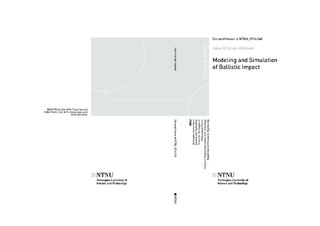| dc.contributor.advisor | Børvik, Tore | |
| dc.contributor.advisor | Hopperstad, Odd Sture | |
| dc.contributor.author | Holmen, Jens Kristian | |
| dc.date.accessioned | 2017-03-17T14:05:29Z | |
| dc.date.available | 2017-03-17T14:05:29Z | |
| dc.date.issued | 2016 | |
| dc.identifier.isbn | 978-82-326-1819-4 | |
| dc.identifier.issn | 1503-8181 | |
| dc.identifier.uri | http://hdl.handle.net/11250/2434567 | |
| dc.description.abstract | Numerical simulations are increasingly becoming an important tool to obtain efficient designs of protective structures, and the existing literature shows that many phenomena can be accurately described by standard methods and models. This thesis, specifically, focuses on novel methods of modeling and simulating ballistic impact. Experiments are needed to validate such simulations, so numerous tests were conducted to investigate how projectile nose-shape, plate layering, target strength, ductility, and work hardening affect the penetration and perforation behavior of various structural configurations. Aluminum plates, steel plates, sand, and sand in combination with aluminum profiles were considered. These tests provide new information about the behavior of materials subjected to ballistic impact, and are valuable input for the evaluation of the numerical simulations. The novel node-splitting method, used to introduce fracture into a numerical model, and a newly implemented discrete particle method were particularly important in this work.
The thesis consists of six individual parts. They are contextualized and linked together by a synopsis which includes a state-of-the-art of numerical modeling of ballistic impact and the objectives and scope of the thesis, along with summaries of the different parts, an overall conclusion and suggestions for further work. Part 1 considers low-velocity impact of layered thin steel plates. Two impactor nose shapes were used: blunt and ogival. The experimental setup is explained in detail and it was found that the resistance to perforation is highest for the blunt-nosed impactor. It was further seen that a monolithic configuration dissipates more energy than a layered configuration of the same thickness. The numerical model was able to predict the correct failure mechanisms and the trends from the experiments; however, a one-to-one relation between simulations and experiments was not obtained. In Part 2, microstructural modeling was used to determine the constitutive behavior of the base material and the heat affected zone (HAZ) of welded Al-Mg-Si aluminum alloy extrusions. Finite element simulations were conducted of impacts by 7.62 mm armor piercing bullets. The experimental validation showed that the purely numerical procedure to estimate the perforation capacity was accurate. Part 3 investigated the influence of target fragmentation on the capacity of plates subjected to ballistic impact. This was done by firing blunt and ogival-nosed projectiles at 20 mm thick plates made of four different tempers of aluminum alloy AA6070. It was shown that strength is not the only important parameter for the perforation resistance; ductility must be factored into the design as well. Node splitting, where new element faces are created at failure, was applied and evaluated in the numerical part. It was found to give as good, or better, results than conventional element erosion. In Part 4, node splitting was used to simulate ballistic impact on layered and surface-hardened steel plates. 7.62 mm armor piercing bullets struck 12 mm thick plate configurations (1x12 mm, 2x6 mm or 3x4 mm). Plate layering was found to be disadvantageous, especially for the surface-hardened plates. Numerical simulations adequately reproduced the experimental behavior. Part 5 and Part 6 looked at penetration and perforation of sand at both high and low impact velocities. A discrete particle method (DPM) where each individual sand grain is treated as a particle was used in the numerical parts of these studies. The DPM gave promising qualitative and quantitative results, and if we also consider results from other studies it becomes clear that the DPM has the potential to be used in a wide range of applications. | nb_NO |
| dc.language.iso | eng | nb_NO |
| dc.publisher | NTNU | nb_NO |
| dc.relation.ispartofseries | Doctoral theses at NTNU;2016:240 | |
| dc.relation.haspart | Paper 1: Holmen, Jens Kristian; Hopperstad, Odd Sture; Børvik, Tore. Low-velocity impact on multi-layered dual-phase steel plates. International Journal of Impact Engineering 2015 ;Volum 78. s. 161-177. http://doi.org/10.1016/j.ijimpeng.2014.12.005 | |
| dc.relation.haspart | Paper 2: Holmen, Jens Kristian; Børvik, Tore; Myhr, Ole Runar; Fjær, Hallvard Gustav; Hopperstad, Odd Sture. Perforation of welded aluminum components: Microstructure-based modeling and experimental validation. International Journal of Impact Engineering 2015 ;Volum 84. s. 96-107. http://doi.org/10.1016/j.ijimpeng.2015.05.016 | |
| dc.relation.haspart | Paper 3: Holmen, Jens Kristian; Johnsen, Joakim; Hopperstad, Odd Sture; Børvik, Tore. Influence of fragmentation on the capacity of aluminum alloy plates subjected to ballistic impact. European journal of mechanics. A, Solids 2016 ;Volum 55. s. 221-233. http://doi.org/10.1016/j.euromechsol.2015.09.009 | |
| dc.relation.haspart | Paper 4: Holmen, Jens Kristian; Solberg, Jan Ketil; Hopperstad, Odd Sture; Børvik, Tore.
Ballistic perforation of layered and surface-hardened steel plates. 1st International Conference on Impact Loading of Structures and Materials (ICILSM 2016); 2016-05-22 - 2016-05-26. | |
| dc.relation.haspart | Paper 5: Holmen, Jens Kristian; Børvik, Tore; Hopperstad, Odd Sture. Experiments and simulations of empty and sand-filled aluminum alloy panels subjected to ballistic impact. Engineering structures 2017 ;Volum 130. s. 216-228. http://doi.org/10.1016/j.engstruct.2016.09.057 | |
| dc.relation.haspart | Paper 6: Holmen, Jens Kristian; Olovsson, Lars; Børvik, Tore.
Discrete modeling of low-velocity penetration in sand. Computers and geotechnics 2017 ;Volum 86. s. 21-32. http://doi.org/10.1016/j.compgeo.2016.12.021 | |
| dc.title | Modeling and Simulation of Ballistic Impact | nb_NO |
| dc.type | Doctoral thesis | nb_NO |
| dc.subject.nsi | VDP::Technology: 500::Building technology: 530::Construction technology: 533 | nb_NO |
